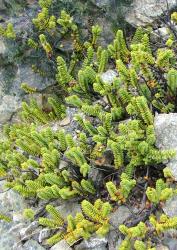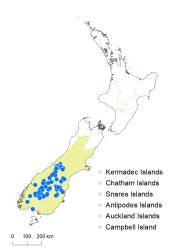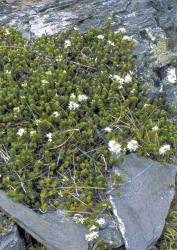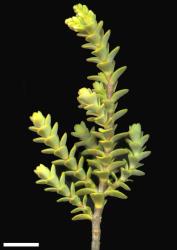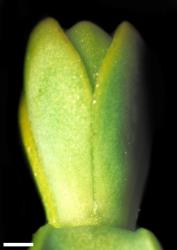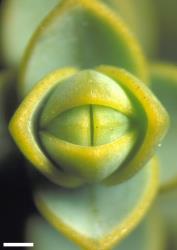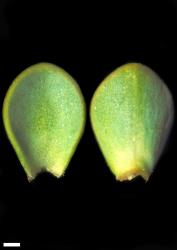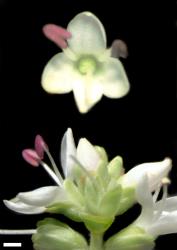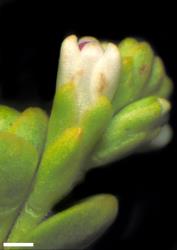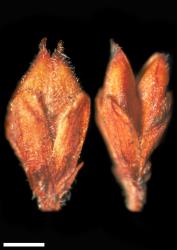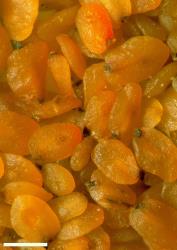- Taxon
- Gallery
- ≡ Hebe buchananii (Hook.f.) Cockayne & Allan, Trans. New Zealand Inst. 57: 36 (1926)
- = Veronica buchananii var. exigua Cheeseman, Man. New Zealand Fl. 527 (1906)
- = Veronica buchananii var. major Cheeseman, Man. New Zealand Fl. 527 (1906)
- ≡ Hebe buchananii var. major (Cheeseman) A.Wall, Trans. & Proc. New Zealand Inst. 60: 384 (1929)
Spreading low shrub to 0.3 m tall. Stems decumbent to erect, eglandular-puberulent or pubescent or sometimes glabrous; hairs bifarious. Leaf bud distinct, its leaves appressed at margins until fully grown; sinus usually absent, sometimes very small, rounded to acute. Leaves opposite-decussate, erecto-patent to spreading, the youngest sub-erect and closely investing the leaf bud; lamina coriaceous, fleshy to rigid, usually obovate to broadly elliptic or orbicular, sometimes lanceolate, 2.5–8.0 mm long, 2–6 mm wide, rarely 1.5 × 1.0 mm, dull glaucous or glaucescent above and beneath; veins not evident, but leaf sometimes keeled beneath; surfaces glabrous; margin glabrous or rarely with a few short, glandular hairs especially near base, often minutely papillate; apex usually obtuse to rounded, occasionally acute to sub-acute; base cuneate; petiole absent. Inflorescence a lateral spike, 5–23 mm long; flowers crowded, 3–12, all bisexual; bracts opposite below, alternate above, usually oblong, ovate or elliptic, sometimes lanceolate-acuminate to deltoid, > pedicels; pedicels usually absent or sometimes erecto-patent, 0–1 mm long, eglandular-hairy all around. Calyx lobes 4, sub-acute to obtuse, 2–3 mm long, sub-equal or equal, usually eglandular-ciliate with a few shorter, glandular hairs as well, occasionally eglandular-hairy abaxially. Corolla 5–7 mm diameter; tube white, 1–2 mm long, ≤ calyx, glabrous; lobes 4, white, sub-erect to spreading, sub-equal to unequal, ovate to lanceolate to elliptic, 2.5–3.0 mm long, obtuse; nectar guides absent. Stamen filaments white, 4.0–4.7 mm long; anthers magenta. Style eglandular-hairy, especially near base, 2.5–5.0 mm long. Capsules latiseptate, sub-acute to obtuse, eglandular-hairy, 2.0–3.7 mm long, 1.9–2.5 mm at widest point. Seeds ovoid-ellipsoid or irregular, weakly flattened, smooth, pale brown, 1–1.5 mm long.
Veronica buchananii plants are small-leaved glaucous hebes with usually close-set almost imbricate leaves and stout branches. The internodes are often wider than long. They usually form low mats, but sometimes stems are more erect and up to 0.3 m tall. The leaves are usually slightly more glaucous above than beneath, and their margins may be reddish but are more usually yellowish-green.
V. pimeleoides plants have leaves of similar size, but they are thinner, narrower, more acute, and usually more distant; their corollas are usually mauve or purple, flowers are always opposite, and their habit is less compact, tending to be more straggly.
V. pinguifolia plants are similar in many respects, but may be identified by their larger, more bluish, glaucous leaves, more than 12 flowers per inflorescence, ciliolate rather than ciliate calyx lobes, and a taller, more lax and shrubby habit.
South Island: Canterbury (south from Malte Brun Range, near Mt Cook), Westland, Otago, Fiordland, Southland.
Penalpine and sub-alpine rocks, stony debris, scrub, and grassland mostly east of the Main Divide. Recorded elevations range from 420 to 1981 m.
At Mt Cook, populations seem to display more variability with respect to habit, leaf size and shape, and length of the hairs on stems and inflorescences (these Mt Cook plants include Cheeseman’s var. exigua and var. major). Moore (in Allan 1961) suggested that some such plants might be hybrids between V. buchananii and V. subalpina.
Flowers: December–March; fruits: February–April, persisting until November.
2n = 40, 80 (see Bayly & Kellow 2006, as Hebe buchananii).
Veronica buchananii is classified in V. subg. Pseudoveronica sect. Hebe and the informal group “Subcarnosae” (Albach & Meudt 2010; Bayly & Kellow 2006).
Indumentum varies, and possibly this has a geographic component. For example, plants from the Garvie Mountains (Bayly 1108 et al., WELT 81444) have almost glabrous peduncles and their bracts and calyx margins have mostly short, glandular hairs (plus a few long, eglandular ones), whereas plants from Mt Ida Range (Petrie, WELT 17134) have dense, eglandular hairs on peduncles and the margins of bracts and calyx lobes, with very few short, glandular hairs. Stem pubescence also varies; the bifarious eglandular hairs may be sparse to dense and short to long.
Plants from the Black Birch Range, Marlborough (e.g., Bayly 748 et al., WELT 80927) are very similar to V. buchananii in overall appearance, but they have been identified as V. pinguifolia because of the short cilia on their bract and calyx margins.



